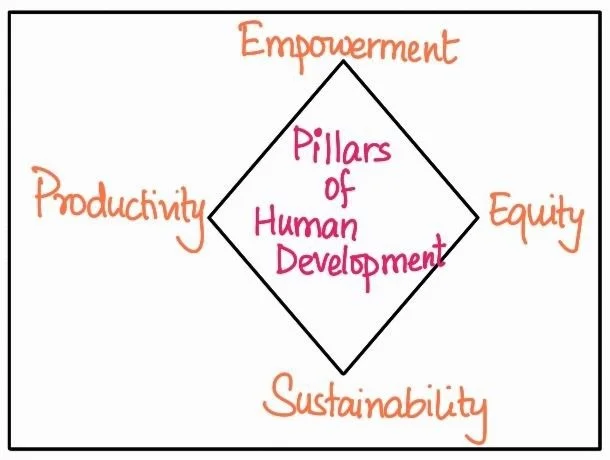![]() 6 Dec 2023
6 Dec 2023
Human resource is considered the ultimate resource as it turns natural elements into useful resources. People differ in their educational levels, age, and sex, and their distribution is not uniform across the world.
Human resources play a crucial role in the success and functioning of an organization by ensuring that the right people are in the right positions, equipped with the necessary skills and resources to contribute effectively to the company’s objectives.
| Criteria | Growth | Development |
| Nature | Quantitative and value-neutral. | Qualitative change and always value-positive. |
| Direction | Can be positive (increase) or negative (decrease). | Requires an addition or improvement to existing conditions. |
| Illustration | An increase in a city’s population | Growth in population and amenities signifies development. |
Table: Comparison between Growth and Development
| Economist | Contribution |
| Dr. Mahbub-ul-Haq |
|
| Prof. Amartya Sen |
|
Table: The Contributions from Dr. Mahbub-ul-Haq and Prof. Amartya Sen

| Pillar | Definition | Implications/Key Points | Examples/Notes |
| Equity | Ensuring equal access to opportunities for everyone. | Opportunities shouldn’t be biased based on gender, race, income, caste, etc. | In India, disparities are observed with many women and socio-economically disadvantaged groups dropping out of school, limiting their future. |
| Sustainability | Maintaining the availability of opportunities over time. | Opportunities should remain consistent for every generation. Utilise resources with future generations in mind. | Not emphasising girls’ education in a community can limit their future career and life choices. |
| Productivity | Focusing on human labor productivity or efficiency in human work. | Human capabilities need enhancement to improve productivity. The true wealth of nations is in its people. | Investments in health and education can lead to better work efficiency. |
| Empowerment | Endowing individuals with the power to make choices. | It comes from increased freedom and capability. Requires effective governance and people-focused policies. | It’s essential to empower socially and economically disadvantaged groups, through strategic human resource initiatives. |
Table: The four pillars of Human Development
| Approach | Description | Key Points |
| Income Approach | One of the oldest methods, linking human development to income. | The level of income is believed to reflect the degree of freedom an individual has. Higher income is associated with a higher level of human development. |
| Welfare Approach | Regards human beings as beneficiaries or targets of all developmental activities. | Advocates for increased government spending on education, health, and social amenities. People are seen as passive recipients, not active participants in development. |
| Basic Needs Approach | Introduced by the International Labour Organisation (ILO) to emphasise the provision of basic necessities. | Identifies six basic needs: health, education, food, water supply, sanitation, and housing. The approach does not focus on individual choices but rather on providing these basic needs. |
| Capability Approach | Linked with Prof. Amartya Sen and emphasises the development of human capabilities. | Key areas of focus for human resource development include health, education, and access to resources. Building human capabilities is central to enhancing human development. |
Table: The four pillars of Human Development
Also Read: HUMAN DEVELOPMENT
Conclusion
Strategic human resource management is central to diverse approaches in human development. Whether focusing on income, welfare, basic needs, or capabilities, the common thread is the recognition that the true wealth of nations lies in nurturing and leveraging human resources. Building capabilities through effective human resource initiatives stands as the linchpin for fostering sustainable, equitable, and empowered societies.
<div class="new-fform">
</div>